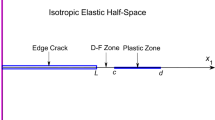Abstract
Distribution of dislocations at a finite mode I crack tip is formulated. Closed form solutions for the dislocation distribution function, the dislocation-free zone (DFZ), the local stress intensity factor and the crack tip stress field are obtained. The dislocation distribution has similar features to a mode III crack model. Under a given applied stress, there may exist different configurations of plastic zone and DFZ. Crack tip shielding by dislocations depends on both applied stresses and the configuration.
Similar content being viewed by others
References
Abramowitz, M. and Stegun, I.A. (1972). Handbook of Mathematical Functions, Dover Publications, New York.
Chang, S.T. and Ohr, S.M. (1981). Dislocation-free zone model of fracture, Journal of Applied Physics 52, 7174-7181.
Chen, J. and Takezono, S. (1995). The dislocation-free zone at a mode I crack tip, Engineering Fracture Mechanics 50, 165-173.
Kobayashi, S, and Ohr, S.M. (1984). Dislocation arrangement in the plastic zone of propagating cracks in nickel, Journal of Materials Science 19, 2273-2277.
Lakshmanan, V. and Li, J.C.M. (1988). Edge dislocations emitted along inclined places from a mode I crack, Materials Science and Engineering A104, 95-104.
Lardner, R.W. (1974). Mathematical Theory of Dislocations and Fracture, University of Toronto Press, Toronto.
Li, C., Zhao, H., Zhan, Z. and Zhou, H. (1992). The DFZ model of fracture at crack tip and crack initiation criterion, Engineering Fracture Mechanics 43, 1009-1017.
Lin, I.H. and Thomson, R. (1986). Cleavage, dislocation emission, and shielding for cracks under general loading, Acta Metallurgica 34, 187-206.
Ohr, S.M. (1985). An electron microscope study of crack tip deformation and its impact on the dislocation theory of fracture, Materials Science Engineering 72, 1-35.
Otsuki, Y. (1983). Mathematical Formulas (translated from Russian), Maruzen, Tokyo.
Rice, J.R. and Thomson, R. (1974). Ductile versus brittle behavior of crystals, Philosophical Magazine 29, 73-97.
Schoeck, G. (1991). Dislocation emission from crack tips, Philosophical Magazine A63, 111-120.
Sinclair, J.E. and Finnis, M.W. (1983). Crack tip blunting versus cleavage extension, in Atomistics of Fracture (Edited by R.M. Latanision and J.R. Pickens), Plenum Press, New York, 1047-1051.
Weertman, J. (1996). Dislocation Based Fracture Mechanics, World Scientific Publishing, Singapore.
Author information
Authors and Affiliations
Rights and permissions
About this article
Cite this article
Chen, J., Kitaoka, S. Distribution of dislocations at a mode I crack tip and their shielding effect. International Journal of Fracture 100, 307–320 (2000). https://doi.org/10.1023/A:1018681016860
Issue Date:
DOI: https://doi.org/10.1023/A:1018681016860




